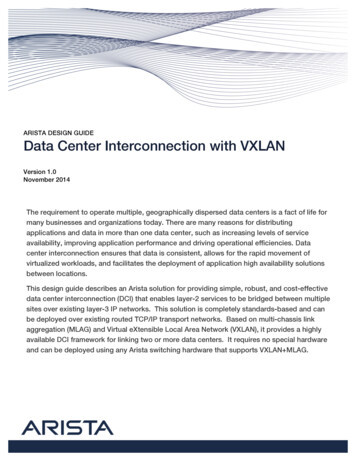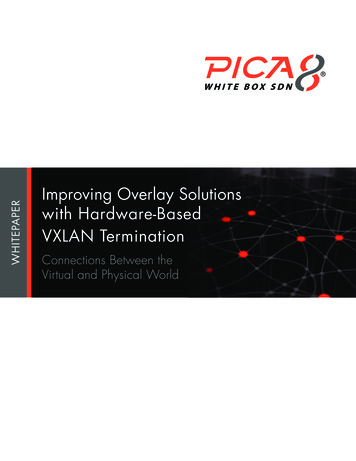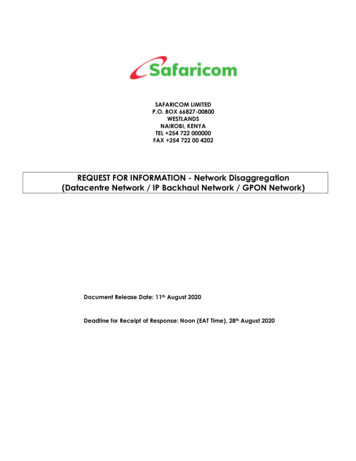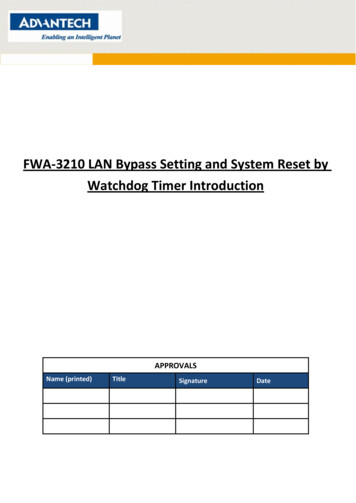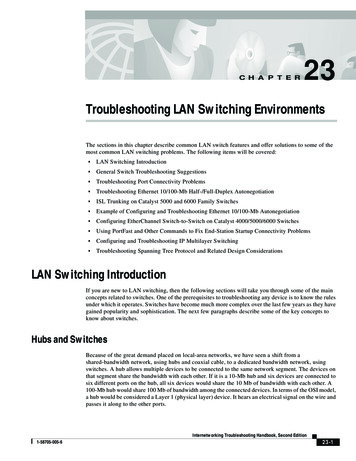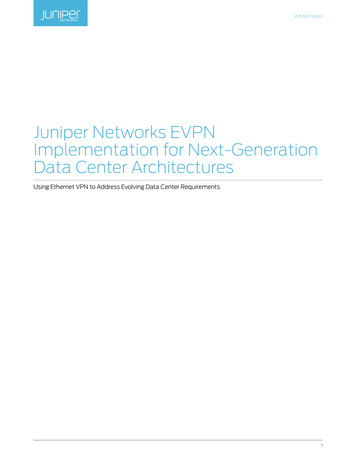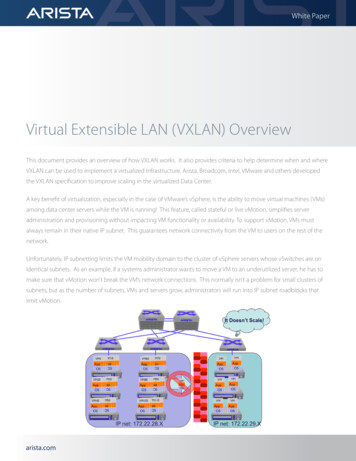
Transcription
White PaperVirtual Extensible LAN (VXLAN) OverviewThis document provides an overview of how VXLAN works. It also provides criteria to help determine when and whereVXLAN can be used to implement a virtualized Infrastructure. Arista, Broadcom, Intel, VMware and others developedthe VXLAN specification to improve scaling in the virtualized Data Center.A key benefit of virtualization, especially in the case of VMware’s vSphere, is the ability to move virtual machines (VMs)among data center servers while the VM is running! This feature, called stateful or live vMotion, simplifies serveradministration and provisioning without impacting VM functionality or availability. To support vMotion, VMs mustalways remain in their native IP subnet. This guarantees network connectivity from the VM to users on the rest of thenetwork.Unfortunately, IP subnetting limits the VM mobility domain to the cluster of vSphere servers whose vSwitches are onidentical subnets. As an example, if a systems administrator wants to move a VM to an underutilized server, he has tomake sure that vMotion won’t break the VM’s network connections. This normally isn’t a problem for small clusters ofsubnets, but as the number of subnets, VMs and servers grow, administrators will run into IP subnet roadblocks thatlimit vMotion.arista.com
White PaperVXLAN Use Cases:Application Examples: Hosting provider provisioning a cloud for its customer VM Farm that has outgrown its IP address space but wants to preserve the data center network architecture Cloud service provider who’s multi-tenant offering needs to scale beyond 802.1q VLANS.Fundamentally, VXLAN provides mechanisms to aggregate and tunnel multiple layer 2 (sub)networks across a Layer 3 infrastructure.The VXLAN base case is to connect two or more layer three network domains and make them look like a common layer two domain.This allows virtual machines on different networks to communicate as if they were in the same layer 2 subnet.Using Virtual Tunnel End Points (VTEPs) to transport multiple virtual networksVXLAN Implementation:The network infrastructure must support the following to support VXLANS: Multicast support: IGMP and PIM Layer 3 routing protocol: OSPF, BGP, IS-ISFor the most part, networking devices process VXLAN traffic transparently. That is, IP encapsulated traffic is switched or routed asany IP traffic would be. VXLAN gateways, also called Virtual Tunnel End Points (VTEP), provide the encapsulating/de-encapsulatingservices central to VXLAN. VTEPS can be virtual bridges in the hypervisor, VXLAN aware VM applications or VXLAN capable switchinghardware. VTEPs are key to virtualizing networks across the existing data center infrastructure.Each VXLAN network segment is associated with a unique 24bit VXLAN Network Identifier, or VNI. The 24 bit address space allowsscaling virtual networks beyond the 4096 available with 802.1Q to 16.7 million possible virtual networks. However, multicast andnetwork hardware limitations will reduce the useable number of virtual networks in most deployments. VMs in a logical L2 domainuse the same subnet and are mapped to a common VNI. It’s the L2 to VNI mapping that lets VMs communicate with one another.Note that VXLAN doesn’t change layer 3 addressing schemes. IP addressing rules employed in a physical L2 still apply to the virtualnetworks.arista.com
White PaperVXLANs maintain VM identity uniqueness by combining the VM’s MAC address and its VNI. This is interesting because it allows forduplicate MAC addresses to exist in a datacenter domain. The only restriction is that duplicate MACs cannot exist on the same VNI.Virtual machines on a VNI subnet don’t require any special configuration to support VXLAN because the encap/decap and VNImapping are managed by the VTEP built into the hypervisor. VXLAN capable switching platforms are similarly responsible for theencap/decap overhead of 802.1q attached network devices. The VTEP must be configured with the layer 2 or ip subnet to VNInetwork mappings as well as VNI to IP multicast groups. The former mapping allows VTEPS to build forwarding tables for VNI/MACtraffic flows and the latter allows VTEPs to emulate broadcast/multicast functions across the overlay network. Synchronizationof VTEP configurations can be automated with common configuration management tools like RANCID, or they can be managedthrough VMware’s vCenter Orchestrator, Open vSwitch or other systems.VXLAN frame encapsulation and forwarding:With these elements in place, the VTEP executes its forwarding rules:1.If the source and destination MAC addresses live on the same host, traffic is locally switched through the vSwitch and no VXLANencap/decap is performed.2.If the destination MAC address is not live on the ESX host, frames are encapsulated in the appropriate VXLAN header by thesource VTEP and are forwarded to the destination VTEP based on its local table. The destination VTEP will unbundle the innerframe from the VXLAN header and deliver it on to the recipient VM.3.For unknown unicast or broadcast/multicast traffic, the local VTEP encapsulates the frame in a VXLAN header and multicaststhe encapsulated frame to the VNI multicast address that is assigned to the VNI at the time of creation. This includes all ARPs,Boot-p/DHCP requests, etc. VTEPs on other hosts receive the multicast frame and process them much the same way unicasttraffic is (see note 2 above).The implementation of this tunneling scheme is relatively simple compared to other schemes, such as MPLS or OTV, because theadministrator only needs to configure VNI or IP mappings and multicast addresses. The rest is managed by the VTEPs.Here are additional details of the frame format:VXLAN header formatEthernet header:With these elements in place, the VTEP executes its forwarding rules:Destination address - This is set to the MAC address of the destination VTEP if its on the same subnet. If the VTEP is on a differentsubnet the address is set to the next hop device, usually a router.VLAN -This is optional for a VXLAN implementation. It will default to the 802.1Q Tagged Prototocol Identifier (TPUD) Ethertype0X8100 and has an associated VLAN ID tag.Ethertype –This is set to 0X0800 to denote an IPv4 payload packet. There’s currently no IPV6 support yet but its under investigationfuture deployment.arista.com
White PaperIP header:Protocol –This is set to 0 11 to indicate it’s a UDP packet.Source IP –This is set to the VTEP source IP addressDestination IP – This is set to the destination VTEP IP address. If unknown/unlearned or is a broad/multi-cast address, then VXLANsimulates a network broadcast using its multicast group. Here’s a brief outline:a.Destination IP is replaced by the IP multicast group that corresponds to the VNI of the source virtual machine.b.Frame is multicast and All VTEPs on the VNI multicast group receive the frame. They in turn unbundle the frame, learn thesource ID and VNI mapping for future use and then forward or drop the packet based on the frame type and local forwardingtable information.c.The VTEP hosting the target virtual machine will encapsulate and forward the virtual machines reply to the sourcing VTEP.d.The source VTEP receives the response and also caches the ID and VNI mapping for future use.UDP headerSource Port -Set by transmitting VTEP. This value can be hashed from the bundled Ethernet headers so that port channel or ecmphashing algorithms can leverage this value for traffic balancing.VXLAN Port -VXLAN IANA port. Vendor specific.UDP Checksum - Should be set by VTEP source to 0 0000. If the receiving VTEP receives a checksum that isn’t 0 0000, the frameshould be checked and discarded if checksum fails.UDP headerVXLAN Flags - Aside from bit 3, the VNI bit, all reserved bits set to zero. The VNI bit is set to 1 for a valid VNI.VNI –This 24-bit field is the VXLAN network ID.Reserved – Reserved fields of 24 and 8 bits that are set to zero.VXLAN packet walkthrough:VXLAN: VM to VM communicationarista.com
White PaperHere’s a packet walkthrough of a session initiated between VMs 1 and 2 residing on different hosts in different IP subnets. Weassume bring up state: no associations have been learned yet. VM1 sends an ARP packet requesting the MAC address associated with 192.168.0.101. The ARP is encapsulated in a Multicast packet by VTEP1 and is multicast to the group associated to VNI 864. All VTEPs associated with VNI 864 receive the packet and add the VTEP1/VM1 MAC mapping to their tables VTEP2 receives the multicast packet, unbundles the frame and floods it to the port groups in VNI 864. VM2 receives the ARP and responds to VM1 with its MAC address. VTEP2 encapsulates the response as a unicast IP packet and forwards it to VTEP1. The response is unicast since VTEP 2 haslearned the VTEP1/VM1 MAC mapping from the original simulated ARP. VTEP1 receives, unbundles and forwards the response packet to VM1.At this point, communications between VM1 and 2 are established and associations are programmed into all relevant statemachines. For any further unicast traffic being sourced from 192.168.0.100 destined to 192.160.0.101, VTEP 1 will take the packetand prepend the following headers:a.VNI VXLAN header 864.b.Standard UDP header with the UDP checksum set to 0 0000 and the VXLAN destination port set to the correct IANA portbased on vendor.c.Destination IP set to the IP address of VTEP 2 and the protocol ID set to UDP, or 0x011.d.Standard MAC header with the next hop MAC address. (In the above example, the next hop is the router interface with MACaddress 00:13:73: 0C: 76: 24.)VTEP2 will receive the packet by way of the intermediary router. The unbundling process is triggered by the UDP header value. VTEP2 now passes the frame to the Vswitch and port groups mapped to VNI 864. The frame is then switched to VM2 for processing. Allreturn traffic is processed in a mirror of the above example.Implementation Considerations:Network datagram payloads and bandwidth utilization:The VXLAN encapsulation header adds 50 bytes to the overall size of an Ethernet frame. Therefore it is imperative the infrastructuresupport jumbo frames. One should also consider the increased bandwidth used to support VXLAN traffic. Juxtaposing multiplenetworks with an increased packet size will consume more bandwidth so its prudent to implement this scheme over 10Gb or highercapacity network technologies.Using standard IP datagrams helps VXLAN offer options for implementing long distance vMotion or High Availability (HA). VXLANframes even take information from the embedded packet to add variability in its packet header to aid load-sharing algorithms.However, if the network designer is interested in leveraging VXLANs in disaster recovery or remote mirrored data center applications,its important to ensure that VMWare vMotion/HA heartbeat round trip delay not exceed 10 milliseconds. Designers can leveragehigh bandwidth, low latency switching with traffic prioritization services to fulfill these requirements and extend the virtualized datacenter.Multicast requirements:As previously mentioned, IP multicast services are used to simulate broadcast, unknown unicast and multicasts within the VXLANnetwork. This is required for VXLANs. While not required, the current recommended configuration is to map one multicast group toeach VNI. This ensures MAC table updates are only sent to VTEPs that require them. It is possible to use only one multicast addressfor every VNI, but this will effectively flood addresses to VTEPs not needing them and create unnecessary traffic flows in the network.arista.com
White PaperPIM sparse, dense mode and BIDIR all provide multicast capabilities to support VXLANs. While some administrators have concernswith PIM, especially those who experienced network outages due to CPU bound PIM processing, its important to note that modernswitching platforms support PIM in hardware and can support large scale PIM deployments without adversely impacting theperformance or reliability of the network.ARP cache and MAC table considerations:VMs in a VXLAN Network communicate to non-virtual networks through a VTEP. VTEPs can either be a software appliance, like avirtual firewall or VMware vShield, or in a VXLAN capable switch. In either case, if the VTEP provides routing services, the ARP cachemust accommodate the number of VMs on the virtual networks it services to avoid unnecessary ARPS.VM traffic encapsulated in VXLAN frames use the MAC IDs of the server’s VTEP. This reduces the number of MAC address entriesin the data center’s physical switches. Ideally, a physical VXLAN network would only be required to learn the MAC addresses forthe VTEPs and management interfaces of the hosts within the data center. However, while this may work in smaller scale VMdeployments, it is prudent to partition VMs and server clusters in subnets to accommodate the traffic volumes sustainable with up todozens of VMs per server.arista.com
White PaperSummaryVXLAN is a powerful tool for extending layer 2 subnets across layer 3 network boundaries. It solves VM portability/vMotionlimitations by encapsulating traffic and extending it across L3 gateways, allowing VMs to be hosted by servers residing on foreignIP subnets. VXLANs can also overlay multiple subnets across a data center infrastructure. The number of virtual networks is limitedonly by the raw bandwidth of the underlying network and the multicast subnets available to simulate broadcast/multicast traffic ofthe VXLAN network. Given the right hardware, VXLANS can eclipse the 4K VLAN limit of 802.1Q without compromising the stabilityof the network. VXLANs use established IP transport along with routing for encapsulated traffic. Therefore, link aggregation, loopdetection and breaking, and path discovery are resolved through tried and proven OSPF, BGP or IS-IS protocols. VXLANs can workon existing infrastructures without the need to retrofit them. Support from VMware, Intel, Broadcom, Arista, Open vSwitch andothers guarantees interoperability and avoids vendor lock in. With VXLANs, systems and network administrators can scale cloudvirtualization to new levels and serve more users cost effectively.Santa Clara—Corporate Headquarters5453 Great America Parkway,Santa Clara, CA 95054Phone: 1-408-547-5500Fax: 1-408-538-8920Email: info@arista.comIreland—International Headquarters3130 Atlantic AvenueWestpark Business CampusShannon, Co. ClareIrelandIndia—R&D OfficeGlobal Tech Park, Tower A & B, 11th FloorMarathahalli Outer Ring RoadDevarabeesanahalli Village, Varthur HobliBangalore, India 560103Vancouver—R&D Office9200 Glenlyon Pkwy, Unit 300Burnaby, British ColumbiaCanada V5J 5J8Singapore—APAC Administrative Office9 Temasek Boulevard#29-01, Suntec Tower TwoSingapore 038989San Francisco—R&D and Sales Office1390 Market Street, Suite 800San Francisco, CA 94102Nashua—R&D Office10 Tara BoulevardNashua, NH 03062Copyright 2016 Arista Networks, Inc. All rights reserved. CloudVision, and EOS are registered trademarks and Arista Networksis a trademark of Arista Networks, Inc. All other company names are trademarks of their respective holders. Information in thisdocument is subject to change without notice. Certain features may not yet be available. Arista Networks, Inc. assumes noresponsibility for any errors that may appear in this document. March 21, 2017 02-0036-02arista.com
VXLAN can be used to implement a virtualized Infrastructure. Arista, Broadcom, Intel, VMware and others developed the VXLAN specification to improve scaling in the virtualized Data Center. A key benefit of virtualization, especially in the case of VMware's vSphere, is the ability to move virtual machines (VMs)
